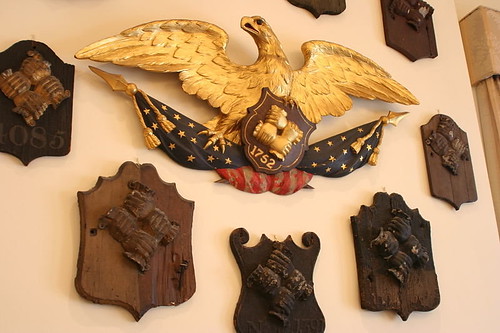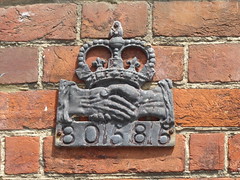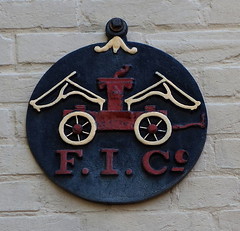
PREV ARTICLE
NEXT ARTICLE
FULL ISSUE
PREV FULL ISSUE
SIGNEVIERISTS: FIRE MARK COLLECTORSNumismatists are known to collect related items in various fields, including antiques. One such collectible category is Fire Marks. I learned about these many years ago from my
friend Armor Murdoch, a fellow member of the Western Pennsylvania Numismatic Society. For information about fire marks, see this excerpt from an August 29, 2017 Atlas Obscura article about
them. -Editor
 DECORATIVE CRESTS BEARING EAGLES, CLASPED hands, and shining suns were once signs of membership in a special club. They showed that the building to which they were affixed was insured against fire—and that if the building caught on fire, a private fire brigade would come to attempt to put it out. Now, long after their heyday, these plaques, known as “fire marks,” have become collector’s items—every bit as fascinating and artful today as they were when they were installed. After the Great Fire of London in September 1666, which damaged or destroyed huge swaths of the historic city, the need for a more organized response to fires became tragically apparent. This led to the creation of the world’s first property insurance policies, issued by what is considered the world’s first insurance company, called the “Fire Office.” Despite its official-sounding name, the Fire Office was not a municipal department, but a private company. At the beginning, it provided money for the restoration or reconstruction of buildings damaged by fire. Not long after the Fire Office was established, a number of other insurance outfits began to appear. According to the Museum of London, one of every 10 houses in London was insured by 1690. As time passed, many insurance companies wised up to the fact that it was cheaper to prevent and fight fires than simply to pay the cost of reconstruction, and that’s where fire marks come in. Insurance companies such as the Fire Office established their own in-house fire brigades, tasked with protecting the buildings covered under policy—and, in many cases, only those buildings. If another company’s brigade put out a fire in a building insured by a different company, they might be reimbursed for their trouble, but if your building did not carry a crest, it might be left to burn. To designate which buildings were covered by which company’s brigade, fire marks were installed on the exteriors of the buildings. By the time that the idea of fire insurance made its way to the Untied States, volunteer fire brigades were already a well-established tradition to protect the common good. Fire marks, which first took hold in Philadelphia, where some can still be found today, functioned simply as insurance advertisements, and as a sort of turf mark.   The most iconic of Philadelphia’s fire marks was that of the Ben Franklin–founded Philadelphia Contributionship, which bore the image of four hands grabbing each other by the wrists. It was often molded out of metal and affixed to a wooden shield. Today, fire marks survive as historic points of interest or collector’s items. Like philatelists and numismatists (collectors of stamps and coins, respectively), people who study and collect fire marks have a name: signevierists. Probably the most organized group of signevierists is the Fire Mark Circle of America, which oversees a number of auctions and connects enthusiasts. Their auction listings even act as a sort of database of the wide variety of preserved marks being traded around. Do we have any fire mark collectors in the house? -Editor
To read the complete article, see:  Wayne Homren, Editor The Numismatic Bibliomania Society is a non-profit organization promoting numismatic literature. See our web site at coinbooks.org. To submit items for publication in The E-Sylum, write to the Editor at this address: whomren@gmail.com To subscribe go to: https://my.binhost.com/lists/listinfo/esylum All Rights Reserved. NBS Home Page Contact the NBS webmaster 
|